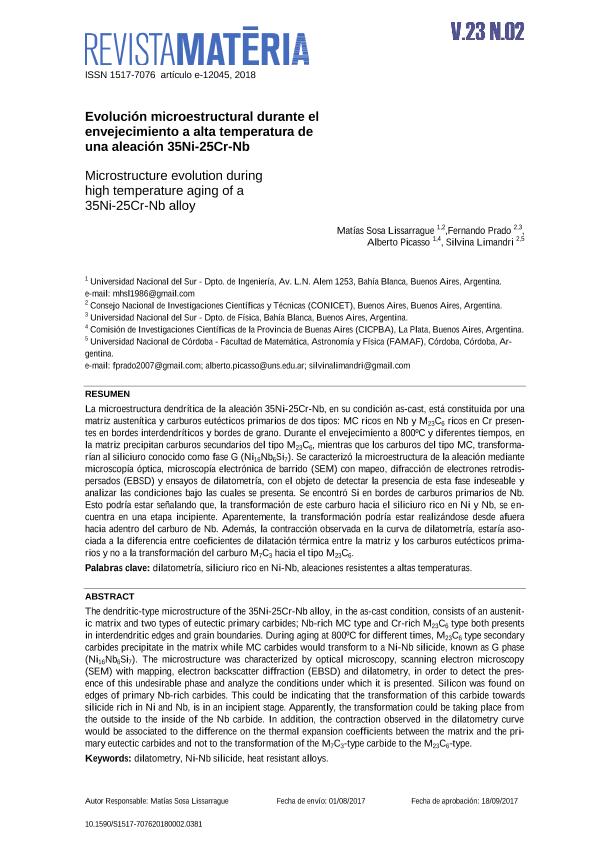Mostrar el registro sencillo del ítem
dc.contributor.author
Sosa Lissarrague, Matías Humberto

dc.contributor.author
Prado, Fernando Daniel

dc.contributor.author
Picasso, Alberto Carlos

dc.contributor.author
Limandri, Silvina Paola

dc.date.available
2019-12-10T18:26:29Z
dc.date.issued
2018-07-09
dc.identifier.citation
Sosa Lissarrague, Matías Humberto; Prado, Fernando Daniel; Picasso, Alberto Carlos; Limandri, Silvina Paola; Evolución microestructural durante el envejecimiento a alta temperatura de una aleación 35Ni-25Cr-Nb; Universidade Federal do Rio de Janeiro; Matéria; 23; 2; 9-7-2018; 1-10
dc.identifier.issn
1517-7076
dc.identifier.uri
http://hdl.handle.net/11336/91924
dc.description.abstract
La microestructura dendrítica de la aleación 35Ni-25Cr-Nb, en su condición as-cast, está constituida por unamatriz austenítica y carburos eutécticos primarios de dos tipos: MC ricos en Nb y M23C6 ricos en Cr presentesen bordes interdendríticos y bordes de grano. Durante el envejecimiento a 800ºC y diferentes tiempos, enla matriz precipitan carburos secundarios del tipo M23C6, mientras que los carburos del tipo MC, transformaríanal siliciuro conocido como fase G (Ni16Nb6Si7). Se caracterizó la microestructura de la aleación mediantemicroscopía óptica, microscopía electrónica de barrido (SEM) con mapeo, difracción de electrones retrodispersados(EBSD) y ensayos de dilatometría, con el objeto de detectar la presencia de esta fase indeseable yanalizar las condiciones bajo las cuales se presenta. Se encontró Si en bordes de carburos primarios de Nb.Esto podría estar señalando que, la transformación de este carburo hacia el siliciuro rico en Ni y Nb, se encuentraen una etapa incipiente. Aparentemente, la transformación podría estar realizándose desde afuerahacia adentro del carburo de Nb. Además, la contracción observada en la curva de dilatometría, estaría asociadaa la diferencia entre coeficientes de dilatación térmica entre la matriz y los carburos eutécticos primariosy no a la transformación del carburo M7C3 hacia el tipo M23C6.
dc.description.abstract
The dendritic-type microstructure of the 35Ni-25Cr-Nballoy, in the as-cast condition, consists of anaustenit-ic matrix and two types of eutectic primary carbides; Nb-rich MC type and Cr-rich M23C6type both presents in interdendritic edges and grain boundaries. During aging at 800ºC for different times, M23C6type secondary carbides precipitate in the matrix while MC carbides would transform to a Ni-Nb silicide, known asG phase (Ni16Nb6Si7). The microstructure was characterized by optical microscopy, scanning electron microscopy (SEM) with mapping, electron backscatter diffraction (EBSD) and dilatometry, in order to detect the pres-ence of this undesirable phase and analyze the conditions under which it is presented.Siliconwas found on edges of primary Nb-rich carbides. This could be indicating that the transformation of this carbide towards silicide rich in Ni and Nb, is in an incipient stage. Apparently, the transformation could be taking place from the outside to the inside of the Nb carbide. In addition, the contraction observed in the dilatometry curve would be associated to the difference on thethermal expansion coefficients between the matrix and the pri-mary eutectic carbides and not to the transformation of the M7C3-typecarbide to the M23C6-type.
dc.format
application/pdf
dc.language.iso
spa
dc.publisher
Universidade Federal do Rio de Janeiro

dc.rights
info:eu-repo/semantics/openAccess
dc.rights.uri
https://creativecommons.org/licenses/by-nc-sa/2.5/ar/
dc.subject
DILATOMETRIA
dc.subject
SILICIURO RICO EN NI-NB
dc.subject
ALEACIONES RESISTENTES A ALTAS TEMPERATURAS
dc.subject.classification
Ingeniería de los Materiales

dc.subject.classification
Ingeniería de los Materiales

dc.subject.classification
INGENIERÍAS Y TECNOLOGÍAS

dc.title
Evolución microestructural durante el envejecimiento a alta temperatura de una aleación 35Ni-25Cr-Nb
dc.title
Microstructure evolution duringhigh temperatureaging of a 35Ni-25Cr-Nb alloy
dc.type
info:eu-repo/semantics/article
dc.type
info:ar-repo/semantics/artículo
dc.type
info:eu-repo/semantics/publishedVersion
dc.date.updated
2019-10-23T17:33:00Z
dc.journal.volume
23
dc.journal.number
2
dc.journal.pagination
1-10
dc.journal.pais
Brasil

dc.description.fil
Fil: Sosa Lissarrague, Matías Humberto. Universidad Nacional del Sur. Departamento de Ingeniería; Argentina. Consejo Nacional de Investigaciones Científicas y Técnicas. Centro Científico Tecnológico Conicet - Bahía Blanca; Argentina
dc.description.fil
Fil: Prado, Fernando Daniel. Universidad Nacional del Sur. Departamento de Física; Argentina. Consejo Nacional de Investigaciones Científicas y Técnicas. Centro Científico Tecnológico Conicet - Bahía Blanca; Argentina
dc.description.fil
Fil: Picasso, Alberto Carlos. Universidad Nacional del Sur. Departamento de Ingeniería; Argentina. Provincia de Buenos Aires. Gobernación. Comisión de Investigaciones Científicas; Argentina
dc.description.fil
Fil: Limandri, Silvina Paola. Consejo Nacional de Investigaciones Científicas y Técnicas; Argentina. Universidad Nacional de Córdoba. Facultad de Matemática, Astronomía y Física; Argentina
dc.journal.title
Matéria

dc.relation.alternativeid
info:eu-repo/semantics/altIdentifier/url/http://ref.scielo.org/hxrgz5
dc.relation.alternativeid
info:eu-repo/semantics/altIdentifier/doi/http://dx.doi.org/10.1590/s1517-707620180002.0381
Archivos asociados
